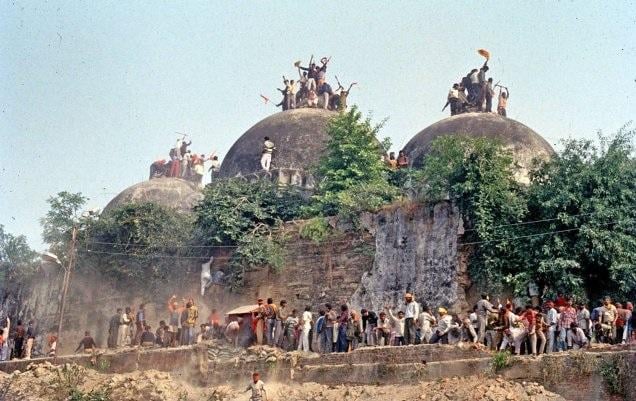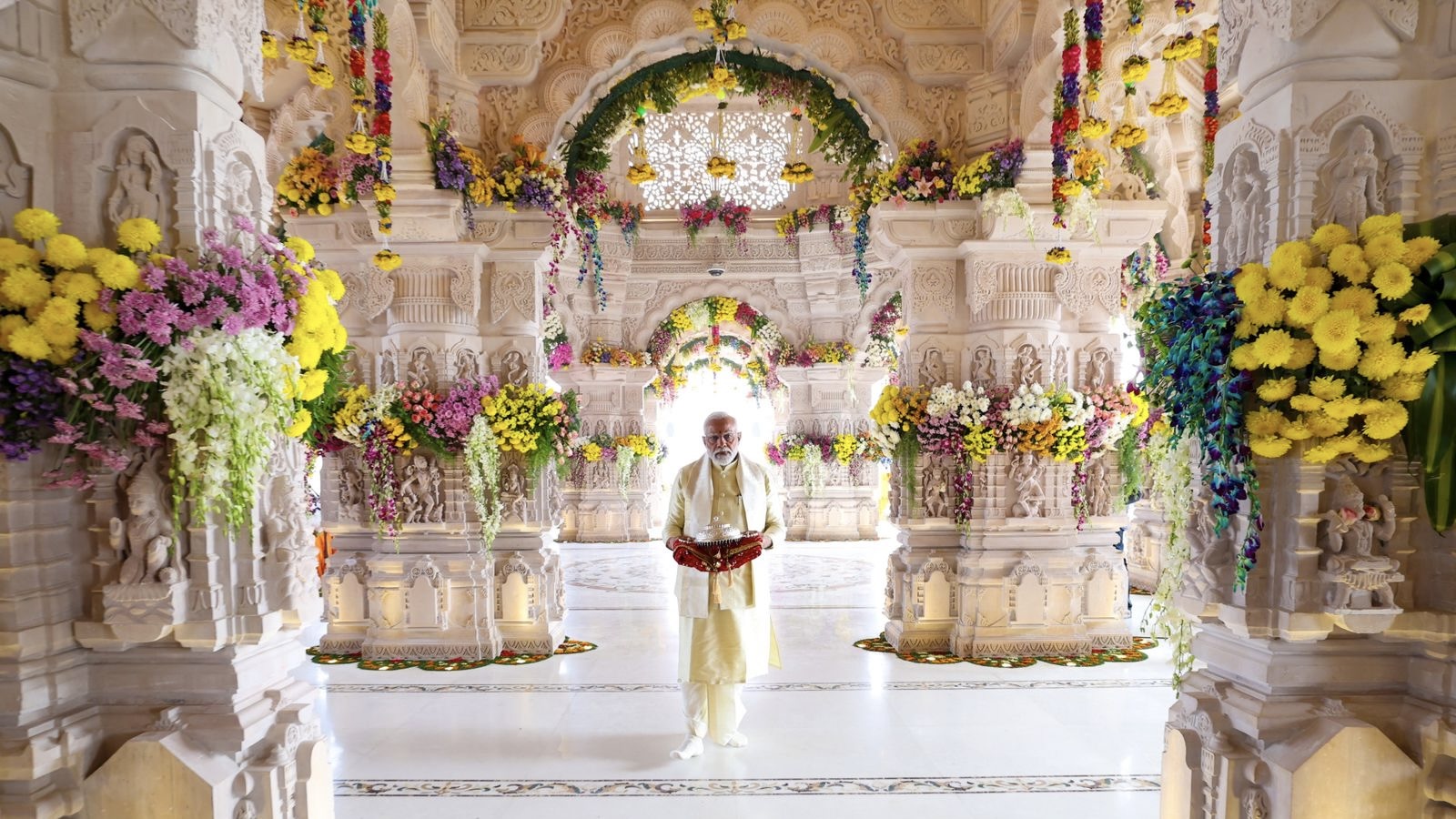On January 22, Indian Prime Minister Narendra Modi performed the consecration ritual at a temple dedicated to the Hindu god Ram in the city of Ayodhya, fulfilling the Bharatiya Janata Party’s (BJP) 2014 electoral promise just months before another general election.
The temple is being constructed on the ruins of the Babri Masjid, a 464-year-old mosque that was destroyed by Hindu extremist mobs on December 6, 1992. Hindu far-right organizations have long claimed that the site is the birthplace of Lord Ram.
While the BJP’s ideological parent, the Rashtriya Swayamsevak Sangh (RSS) and its affiliated organizations that comprise the umbrella Sangh Parivar, had maintained that the demolition of the mosque was the result of spontaneous mobilizations of kar sevaks (religious devotees), reports and accounts, particularly the Liberhan Commission inquiry stated otherwise.
In its report, the inquiry concluded that “the mobilization of kar sevaks and their convergence to Ayodhya and Faizabad was neither spontaneous nor voluntary. It was well orchestrated and planned.” It held responsible senior political figures including former prime minister Atal Bihari Vajpayee and former BJP president Lal Krishna Advani.
In 1990, Adavni had mobilized thousands of right wing kar sevaks for a violent 16-state yatra (procession) destined for Ayodhya in support of the Sangh Parivar’s campaign to build a Ram temple.
Following the demolition of the mosque in 1992, over 2,000 people, the majority of whom were Muslims, were killed in the sectarian violence that followed the events of December 6.
The demolition of the mosque is considered a turning point in Indian history— with the ascendance of Hindu nationalism to the political mainstream, and with it, a decisive departure from the values of secularism enshrined in the Indian constitution.
Demise of secularism
Three decades later, with the BJP in power at the center, the foundation stone of the temple in Ayodhya was laid by the head of government in a country where there is no official state religion.
“The Ayodhya ceremony is to proclaim Hindutva [the political ideology of Hindu nationalism] as the State ideology,” stated the Communist Party of India (Marxist), which was the first national political party to decline an invitation to attend the consecration ceremony and was soon followed by the Indian National Congress (INC).
“It is to symbolize the convergence of Hindutva and State power. The identification of Narendra Modi as prime minister and the progenitor of Ram Rajya is complete with his leading role in the consecration of the Ram temple.”
Earlier this month, Modi had proclaimed that God had made him “an instrument to represent all the people of India during the consecration.”
“At this historic moment, every city and village in the country has been turned into Ayodhya, and every path seems to be heading towards the Ram Janmabhoomi [birthplace],” declared Uttar Pradesh Chief Minister Yogi Adityanath.
“The Ram temple, nation, and State have all been morphed together,” the CPI(M) had said.
In his address following the consecration ritual, Modi stated that Ram had resided in the first page of the Indian Constitution. He went on to state, “Even after the Constitution came into existence, the legal battle over the existence of Lord Ram went on for decades. I would like to the thank judiciary that delivered justice and Lord Ram’s temple was built in a legal manner.”
Courts bow to BJP?
While the dispute over the Babri Masjid, which was built during the reign of Mughal emperor Babur, dates back to the mid-19th century, the situation changed dramatically in December 1949, when an idol of Ram as an infant was smuggled in and placed under the mosque’s central dome by local Hindu right-wing outfits.
Subsequently, the doors of the mosque, where Muslims had offered prayers, were locked. In the 1950s, court rulings paved the way for Hindus to offer prayers at the site. By 1986, a district court judge in Faizabad ordered that the gates be unlocked and Hindus be allowed to worship at the site, with the ruling allegedly issued on orders from within the government of Prime Minister Rajiv Gandhi.
In 1989, competing lawsuits over the ownership of the site, dating back to the late 1950s and early 60s, were shifted to the Allahabad High Court. The Court would deliver a verdict on the matter in 2010— years after the mosque had already been demolished.

The land was divided into three parts: the area under the central dome was given to the Hindu claimants, which included the Nirmohi Akhara and Ram Lalla Virajman (a title claimant on behalf of Lord Ram) and the outer courtyard was given to the Sunni Wakf Board, who represented Muslims. All parties appealed the ruling in the Supreme Court.
In November 2019, after a period of unsuccessful mediation, the Court delivered its verdict in a unanimous judgment that did not bear the name of its author. The ruling handed over the entire Babri Masjid site to Ram Lalla Virajman.
This is despite the fact that the Court had acknowledged that the mosque had been “desecrated by the installation of Hindu idols” in 1949 and that the subsequent ouster and exclusion of Muslims “was not through any lawful authority.” However, the conclusion the Court drew from this, and a previous bout of violence in 1934 was that “Muslims did not have exclusive possession over the inner courtyard”.
The Court further determined that the destruction of the mosque in 1992 was “an egregious violation of the rule of law”. Despite this, the Supreme Court ordered the allocation of an alternate site to the Sunni Waqf Board. Meanwhile, ownership of the site was to be given to a trust for the construction of the Ram temple.
Soon after his retirement, then Chief Justice of India, Ranjan Gogoi, who had been a member of the bench that delivered the verdict, was nominated by the Indian government to the upper house of Parliament.
In 2020, a special court in Lucknow acquitted Advani and 31 others accused which included senior Sangh Parivar leadership in the Babri Masjid violence. This was a month after PM Modi laid the foundation stone at the temple.
“It is the judiciary at the highest level that has installed the Ram Mandir on the broken remains of Babri Masjid, and has launched the Ram Janmabhoomi movement into a destructive orbit of spatiocide,” legal researcher and sociologist, Kalpana Kannabiran, told Scroll.
Over three years later, the role played by the machinery of the Indian state in the temple’s consecration was also clear in the slate of official notices that were sent out in the preceding days.
What raised major concern was the announcement that all hospitals run by the Union government in Delhi would be shut for half of the day on January 22. While the All India Institute of Medical Sciences (AIIMS) later rescinded its notification, other three central hospitals in Delhi had issued no such notifications as of Sunday afternoon, affecting thousands of people in need of out-patient and diagnostic services.
January 22 was also declared a half-day off for all government offices, central institutions and industrial establishments for employees to be able to “participate in the celebrations for Ram Lalla Pran Pratishtha at Ayodhya”. Several state governments, particularly those led by the BJP, declared a half-day, and even a full public holiday, including the shutting down of schools and universities.
The Students’ Federation of India (SFI) stated that the decision reflected “a larger project of politicizing religion and the State, which we must resist and counter with a strong and principled defense of secularism.”
In his address after the consecration of the temple, PM Modi stated that the ceremony was heralding a “new era” in India: “Ram is the basis of India,” he said.
What does India look like now— where chants of “Jai Shri Ram” (Hail Lord Ram) are raised to usher in a “new era” on one hand and are associated with the persecution of the marginalized citizenry on the other?





